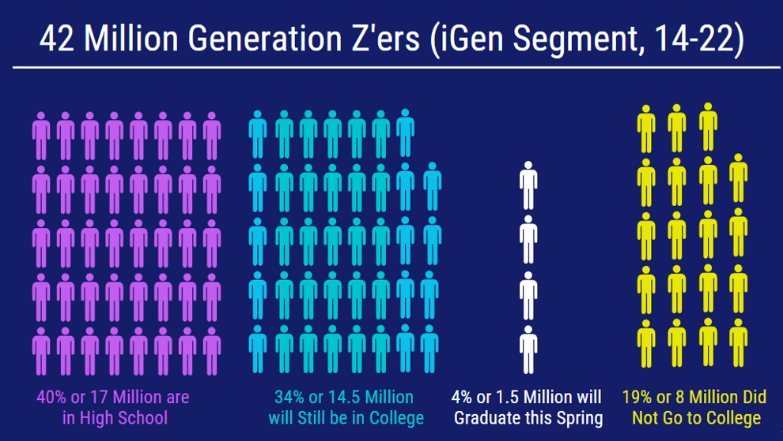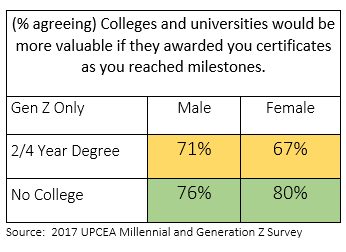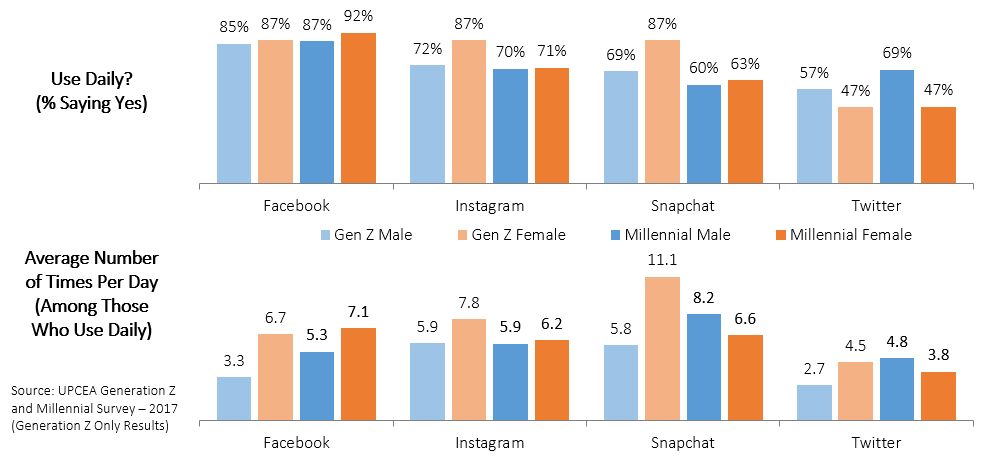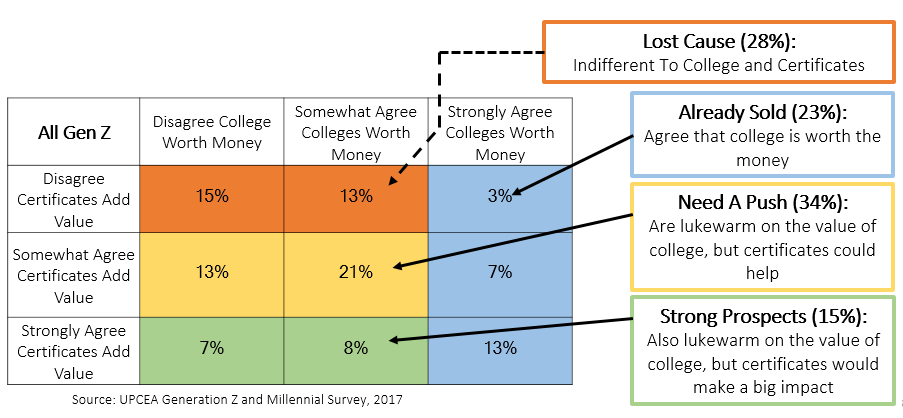
Over the past decade, the resource-constrained system of higher education has made great strides to serve the adult learner and better prepare the workforce. Having been amply warned at the start of this century, higher education has adapted its traditional systems of serving Baby Boomers through evening and weekend degree completion programs to more advanced online degree programs that reach Generation X and older millennials. Many higher education institutions have adapted and invested appropriately in personnel, technology, processes and systems. These investments, however, will have limited shelf life as new and very different generations will be disruptive in their engagement with higher education. The first major cohort of Generation Z, over one million strong, is expected to graduate college in spring of 2018. Eight million did not go to college and are already in the workforce, while another 32 million are in high school or college.
Many higher education leaders and administrators have grown content and even complacent in their new online degree programs, professional master’s degrees, and massive open online courses (MOOCs). However, the next generation is distinctly different and will challenge systems, processes and programs designed around previous generations. The iGeneration, those age 14 to 22, is a segment of Generation Z and true “digital natives.” This generation is the most informed and connected; its members are thus savvy consumers. For higher education institutions and those with corporate or adult learning programs, the iGeneration could be a source of great opportunity or a challenge if we do not properly prepare for them.Over the past decade, the resource-constrained system of higher education has made great strides to serve the adult learner and better prepare the workforce. Having been amply warned at the start of this century, higher education has adapted its traditional systems of serving Baby Boomers through evening and weekend degree completion programs to more advanced online degree programs that reach Generation X and older millennials. Many higher education institutions have adapted and invested appropriately in personnel, technology, processes and systems. These investments, however, will have limited shelf life as new and very different generations will be disruptive in their engagement with higher education. The first major cohort of Generation Z, over one million strong, is expected to graduate college in spring of 2018. Eight million did not go to college and are already in the workforce, while another 32 million are in high school or college.
From a marketing perspective, the definitions of the traditional 4 P’s of marketing–price, promotion, place and product are different for iGen. This generation communicates quite differently than Boomers or Generation Xers. Baby Boomers desire a personal relationship and are comfortable picking up the telephone. Generation X quickly became the email or internet generation. Millennials were the start of the mobile generation and are highly dependent on the media channel they helped develop—text messaging and mobile communication. The iGeneration or Generation Z is the information generation that relies more on video and audio. This generation, while having many similar qualities with millennials, finds texting and typing less efficient. As a result, they have developed emoji languages to become more efficient and are more likely to utilize pictures and video in their communication.
Pricing, the first P, is a complex and critical factor for those working with the iGeneration. They are informed consumers, often involved with their family’s finances and sharing costs of goods with friends through ride, home and food sharing. As a result, many have online payment accounts such as ApplePay, Venmo, Google Pay, and PayPal, as well as electronic banking that allows them to move money easily. They conduct information searches prior to shopping and are adept at online purchases with many having company-specific apps for regular purchases. As a result, they are not easily fooled by quick or non-scientific pricing strategies, and they wield significant power in the pre- and post-purchase decisions. Higher education institutions that take a cost basis for pricing, without consideration of how iGen values education and how competitors are price positioned, are likely to suffer the consequences of enrollment declines. iGen consumers will search out competitive prices, consider their own long-term goals, and ultimately make decisions on perceived returns on investment. Therefore, institutions of higher education need to research their decisions and price programs not on legacy values, but on true marketplace criteria and forces.
Promotion or marketing to iGen is challenging for higher education. Colleges and universities have invested significantly in telephone-based inquiry systems and intake centers. Many institutions are also playing “catch up” regarding their digital marketing, having text-heavy Web 2.0 websites and a minimal social media presence. Members of iGen, having access to technology and being conditioned for information searches, will silently search institutional websites well upstream of a telephone call and an eventual purchase. This generation also searches unofficial ranking and rating sites and will also seek the advice of their network of family and friends, so an institution may never even hear from this silent shopping generation.
Communicating with iGen has its challenges, as this generation is still evolving with technology, commerce, and major societal changes. Companies such as Facebook are working diligently to attract iGen and are threatened by the minimal use of its platform by them. Facebook has built out features such as Instagram and WhatsApp to better serve this generation, emulating its competitor Snapchat, and is improving messaging, news, and advertising features. Google and Twitter are also investing in dethroning Snapchat as the preferred social media service for iGen.
The chart above shows that Generation Z, especially females, prefers Snapchat and use it frequently in a typical day. They also use a variety of other social media platforms but with different and often less frequency. This, along with UPCEA research conducted jointly with Blackboard, shows that Millennials and iGen use multiple communication and social media platforms. Both generations understand the need for email and use of an institutional website, although they may not necessarily prefer it. They acknowledge these communications channels as being more formal.

Place and Product decisions are also critical for higher education and are interrelated. Higher education has responded to Place by creating systems and processes for delivering online degrees and courses to adult and corporate learners. However, these systems are designed for a larger and more profitable investment, the online degree. One could argue that the college degree is a bundled product of the Greatest Generation, Baby Boomer and Generation X that higher education has forced millennials and Generation Z to accept, despite their preferences for smaller packages and more frequent awards. Higher education has addressed one part of the equation, online, but only until recently has begun to address the other part —a smaller and more flexible credential.
One could argue that the college degree is a bundled product of the Greatest Generation, Baby Boomer and Generation X that higher education has forced millennials and Generation Z to accept, despite their preferences for smaller packages and more frequent awards. Higher education has addressed one part of the equation, online, but only until recently has begun to address the other part —a smaller and more flexible credential.
In fact, alternative credentials, such as certificates or courses that lead to a credential or badge, have greater appeal to both those in college and those not seeking to attend college initially, as well as for both males and females. The chart below shows that just 28 percent of Generation Z would not value the college experience or a certificate-based educational experience. Twenty-three percent prefer a more traditional experience and almost one-half (49 percent) have a preference toward degrees and may not necessarily agree that the traditional college–based experience is worth the money. As a result, there are different marketing opportunities and approaches, as well as program development considerations, when offering certificates or other alternative credentials to Generation Z.
Professional, continuing, and online education units simply cannot say they do not have time to adapt to Generation Z or that Generation Z is not their market. Generation Z is here and will set new standards for customer service and program development. This group will have significant power and influence, and professional and continuing education units need to start adapting existing systems and begin developing new systems as the iGen masses line up at their doorsteps in the very near future. A failure to do so may result in a damaged reputation spread through an iGen’s social network and forever displayed on a consumer review site. The future adult learner is here.
Jim Fong is the founding director of UPCEA’s Center for Research and Strategy. He has extensive background in marketing at Penn State, as well as experience in private industry. Jim often presents at UPCEA’s regional and national conferences, sharing vital information with attendees.



